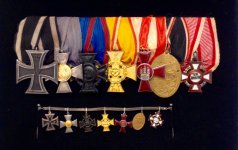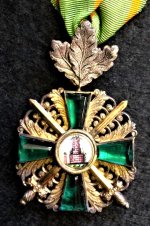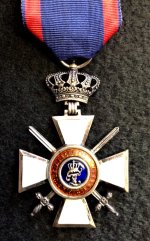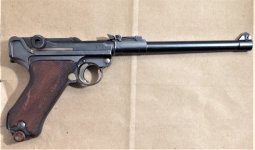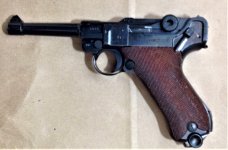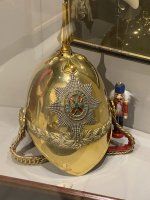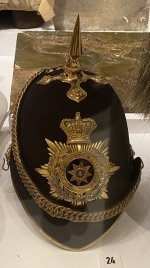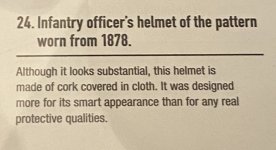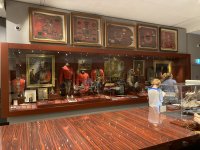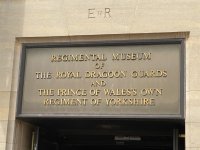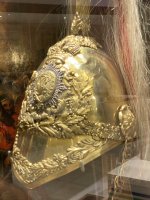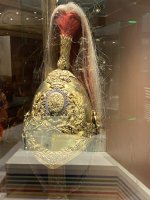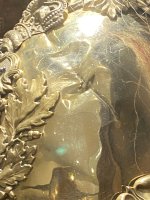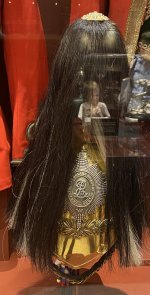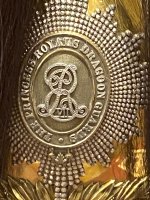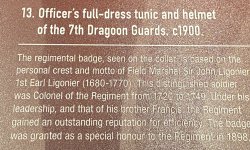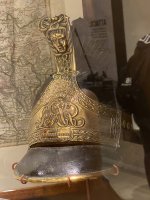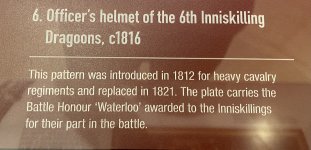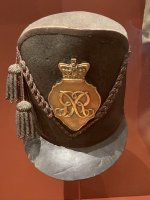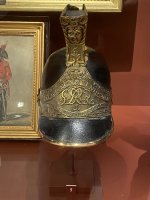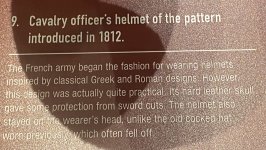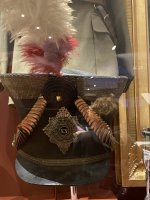Yeohelmetguy
Well-known member
As a follow-up to my last post featuring my officers 1878 pattern home service helmet to the Loyal North Lancashire Regiment and a couple of the regiments associated officers helmet plates, I thought it might be of interest to the Forum members to showcase the variety of helmet plates worn by Victorian British Army regiments from 1878 through 1901. I am featuring only about twenty-five of the hundreds that would have been worn by regular army regiments and the volunteer battalions to the regular regiments and the volunteer regiments as they existed prior to the Cardwell and Childers reforms to the British Army in the 1870’s and 1880’s that did away with the old numbered regimental titles replacing them with new county associated titles based on where the regiment was located and recruited. The then independent volunteer regiments were incorporated into the regular army structure as volunteer battalions to the regular regiments. As examples of the name changes the 1st Regiment of Foot became the “The Lothian Regiment” or Royal Scots and the 44th (East Essex) Regiment of Foot and the 56th (West Essex) Regiment of Foot were amalgamated to from the new two battalion regiment the “Essex Regiment.”
I have arranged the images in to three distinct groups for easy understanding of where they fit into the army reforms mentioned above. The gilt helmet plates are those plates worn by officers in regular regiments post 1881 Caldwell/Childers reforms where the regiments became two battalion county regiments. The second group, in silver plate, are plates worn by officers in volunteer battalions to the regular army regiments post 1881. The third group, also in silver plate, are officers helmet plates to independent volunteer regiments as worn prior to 1881 (1878 to 1881). These regiments, after 1881, were renamed and renumbered as volunteer battalions to the regular regiments.
OFFICERS REGULAR ARMY REGIMENTS 1881-1901:
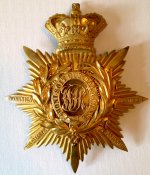
Officers home service helmet plate attributed to the West India Regiment as worn 1888 through 1901. The plate is entirely in gilt with, to the center, an intertwined "WIR" monogram on a gilt background, this then surrounded by the garter and motto, this in turn surrounded by laurel leaves to the left and palm fronds to the right all on a universal eight-pointed star, the upper most point replaced by a Victorian crown. Four battle honors are displayed on the rays of the star, Dominica and Guadeloupe on the left and Martinique and Ashantee on the right. The West India Regiment was formed in 1888 by the merging of the 1st and 2nd West India Regiments.
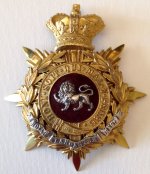
Officer's Home Service Helmet Plate to the King's Own (Royal Lancashire Regiment) as worn from 1883 to 1901. The plate. consisting of a star with the upper most point surmounted by a Victorian crown to which is mounted a laurel wreath and within the laurel wreath the garter and motto and to the center mounted on crimson velvet ground in silver the Lion of England. Below is the universal scroll in silver inscribed "Royal Lancashire Regt". The center velvet ground was changed from scarlet velvet to crimson velvet in 1900.
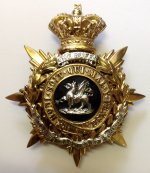
Helmet Plate attributed to The East Kent Regiment (The Buffs) 1891 to 1901, gilt plate with silver title scrolls above the central device inscribed “The Buffs” and below the universal title scroll inscribed “The East Kent Regiment”. the central device, the Dragoon is mounted on black velvet.
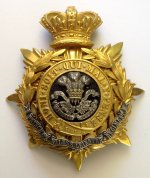
Helmet Plate attributed to The Prince of Wales's Leinster Regiment (Royal Canadians) 1891 to 1890, gilt star and garter with silver regimental title scroll inscribed “Prince of Wales Leinster Regiment” and the Prince of Wales's Plumes in silver with gilt cornet central device mounted on a black velvet ground.
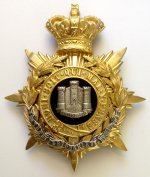
Helmet Plate attributed to The Devonshire Regiment as worn 1881 to 1890, gilt star and garter the central device, the Castle of Exeter with a scroll inscribed “Semper Fidelis” set on a black velvet ground and the universal regimental title scroll inscribed “The Devonshire Regiment” in silver.
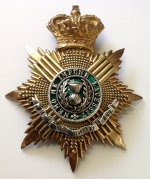
Helmet Plate attributed to The Lothian Regiment 1883 to 1890. The universal wreath is displaced with the Star of the Order of the Thistle in gilt on which is mounted a silver circle pierced “Nemo Me Impune Lacessit” on a green enameled ground. Within the circle on a convex green enameled ground, the Thistle in silver. The universal title scrolls inscribed “The Lothian Regiment”. The title was changed to read "The Royal Scots" approximately 1890. This plate displays a good bit of wear due to excessive polishing.
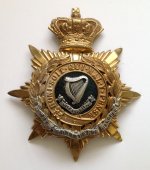
Helmet Plate attributed to The Connaught Rangers as worn from 1881 to 1890. The plate is in gilt with as its central device the Harp with a scroll below inscribed "Quis separabit" in silver on a deep green velvet background and the universal regimental title scroll below inscribed “The Connaught Rangers” also in silver.
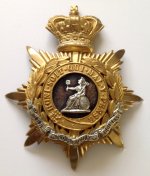
Helmet Plate attributed to The Norfolk Regiment as worn from 1881 to 1890. The plate is gilt with the image of "Britania" as the central device in silver set on a black velvet ground and a silver regimental title scroll below inscribed “The Norfolk Regiment”.. This is a later version of the central device with "Britania's" hand raised. The black velvet ground showing wear.
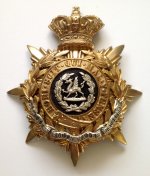
Helmet Plate attributed to The South Wales Borderers Regiment as worn from 1881 to 1890. The plate is gilt and the central device which consisted of the Welsh Dragon within a laurel wreath in silver set on a black velvet ground with a silver universal title scroll inscribed "The South Wales Borderers".
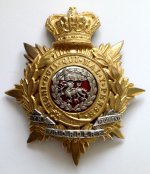
Helmet Plate attributed to The Border Regiment as worn from 1881 to 1884. The plate is in gilt with as the central device in silver, the "Dragon of China" with a scroll above inscribed "China" surrounded by a laurel wreath set on a ground of white and red enamel with below, a scroll of special pattern inscribed "The Border Regiment".
OFFICERS VOLUNTEER BATTALIONS 1881-1901:
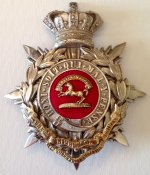
Officer's Home Service Helmet Plate to the King's (Liverpool Regiment), 6th Volunteer Battalion as worn from 1883 to 1901. The helmet plate consists of an eight-pointed star with the upper most point surmounted by a Victorian crown to which is mounted a laurel wreath surrounding the grater and motto and within the garter on a velvet crimson ground the White Horse in gilt. Below is the universal scroll inscribed "The Liverpool Regiment" with a supplemental scroll inscribed "6th Volunteer Battalion below all in gilt.
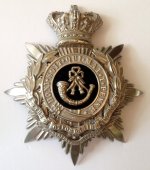
Helmet Plate attributed to The Oxfordshire Light Infantry Regiment, 2nd Volunteer Battalion, all silver plate, the central device, a strung bugle horn set on a black velvet ground. The universal title scrolls inscribed “The Oxfordshire Lt Infy”.
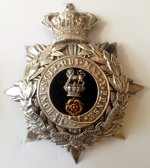
Helmet Plate attributed to The Loyal North Lancashire Regiment, Volunteer Battalion, all silver plate except for the rose and silver Royal Crest in the central device, the rose in gilt and red and green enamel all on a black velvet ground. On the universal title scroll the regiments title inscribed “Loyal North Lancashire Regiment”.
CONTINUED IN PART TWO...
David
I have arranged the images in to three distinct groups for easy understanding of where they fit into the army reforms mentioned above. The gilt helmet plates are those plates worn by officers in regular regiments post 1881 Caldwell/Childers reforms where the regiments became two battalion county regiments. The second group, in silver plate, are plates worn by officers in volunteer battalions to the regular army regiments post 1881. The third group, also in silver plate, are officers helmet plates to independent volunteer regiments as worn prior to 1881 (1878 to 1881). These regiments, after 1881, were renamed and renumbered as volunteer battalions to the regular regiments.
OFFICERS REGULAR ARMY REGIMENTS 1881-1901:

Officers home service helmet plate attributed to the West India Regiment as worn 1888 through 1901. The plate is entirely in gilt with, to the center, an intertwined "WIR" monogram on a gilt background, this then surrounded by the garter and motto, this in turn surrounded by laurel leaves to the left and palm fronds to the right all on a universal eight-pointed star, the upper most point replaced by a Victorian crown. Four battle honors are displayed on the rays of the star, Dominica and Guadeloupe on the left and Martinique and Ashantee on the right. The West India Regiment was formed in 1888 by the merging of the 1st and 2nd West India Regiments.

Officer's Home Service Helmet Plate to the King's Own (Royal Lancashire Regiment) as worn from 1883 to 1901. The plate. consisting of a star with the upper most point surmounted by a Victorian crown to which is mounted a laurel wreath and within the laurel wreath the garter and motto and to the center mounted on crimson velvet ground in silver the Lion of England. Below is the universal scroll in silver inscribed "Royal Lancashire Regt". The center velvet ground was changed from scarlet velvet to crimson velvet in 1900.

Helmet Plate attributed to The East Kent Regiment (The Buffs) 1891 to 1901, gilt plate with silver title scrolls above the central device inscribed “The Buffs” and below the universal title scroll inscribed “The East Kent Regiment”. the central device, the Dragoon is mounted on black velvet.

Helmet Plate attributed to The Prince of Wales's Leinster Regiment (Royal Canadians) 1891 to 1890, gilt star and garter with silver regimental title scroll inscribed “Prince of Wales Leinster Regiment” and the Prince of Wales's Plumes in silver with gilt cornet central device mounted on a black velvet ground.

Helmet Plate attributed to The Devonshire Regiment as worn 1881 to 1890, gilt star and garter the central device, the Castle of Exeter with a scroll inscribed “Semper Fidelis” set on a black velvet ground and the universal regimental title scroll inscribed “The Devonshire Regiment” in silver.

Helmet Plate attributed to The Lothian Regiment 1883 to 1890. The universal wreath is displaced with the Star of the Order of the Thistle in gilt on which is mounted a silver circle pierced “Nemo Me Impune Lacessit” on a green enameled ground. Within the circle on a convex green enameled ground, the Thistle in silver. The universal title scrolls inscribed “The Lothian Regiment”. The title was changed to read "The Royal Scots" approximately 1890. This plate displays a good bit of wear due to excessive polishing.

Helmet Plate attributed to The Connaught Rangers as worn from 1881 to 1890. The plate is in gilt with as its central device the Harp with a scroll below inscribed "Quis separabit" in silver on a deep green velvet background and the universal regimental title scroll below inscribed “The Connaught Rangers” also in silver.

Helmet Plate attributed to The Norfolk Regiment as worn from 1881 to 1890. The plate is gilt with the image of "Britania" as the central device in silver set on a black velvet ground and a silver regimental title scroll below inscribed “The Norfolk Regiment”.. This is a later version of the central device with "Britania's" hand raised. The black velvet ground showing wear.

Helmet Plate attributed to The South Wales Borderers Regiment as worn from 1881 to 1890. The plate is gilt and the central device which consisted of the Welsh Dragon within a laurel wreath in silver set on a black velvet ground with a silver universal title scroll inscribed "The South Wales Borderers".

Helmet Plate attributed to The Border Regiment as worn from 1881 to 1884. The plate is in gilt with as the central device in silver, the "Dragon of China" with a scroll above inscribed "China" surrounded by a laurel wreath set on a ground of white and red enamel with below, a scroll of special pattern inscribed "The Border Regiment".
OFFICERS VOLUNTEER BATTALIONS 1881-1901:

Officer's Home Service Helmet Plate to the King's (Liverpool Regiment), 6th Volunteer Battalion as worn from 1883 to 1901. The helmet plate consists of an eight-pointed star with the upper most point surmounted by a Victorian crown to which is mounted a laurel wreath surrounding the grater and motto and within the garter on a velvet crimson ground the White Horse in gilt. Below is the universal scroll inscribed "The Liverpool Regiment" with a supplemental scroll inscribed "6th Volunteer Battalion below all in gilt.

Helmet Plate attributed to The Oxfordshire Light Infantry Regiment, 2nd Volunteer Battalion, all silver plate, the central device, a strung bugle horn set on a black velvet ground. The universal title scrolls inscribed “The Oxfordshire Lt Infy”.

Helmet Plate attributed to The Loyal North Lancashire Regiment, Volunteer Battalion, all silver plate except for the rose and silver Royal Crest in the central device, the rose in gilt and red and green enamel all on a black velvet ground. On the universal title scroll the regiments title inscribed “Loyal North Lancashire Regiment”.
CONTINUED IN PART TWO...
David

